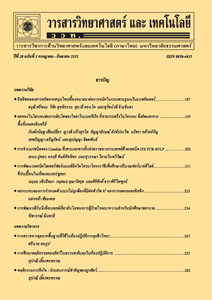ผลของถ่านชีวภาพร่วมกับการจัดการปุ๋ยต่อผลผลิตและความเข้มข้นธาตุอาหารในถั่วฝักยาวไร้ค้าง
Main Article Content
Abstract
Biochar is an effective material for carbon sequestration in the soil and encouragement soil physical, chemical and biological properties. The aim of this experiment was to study the effect of biochar application with fertilizer management on growth, yield, nutrient concentration and nutrient accumulation in dwarf yard long bean cv. KKU 25 and residual nutrient content in postharvest material. The experimental design was arranged in 2 x 4 factorial in CRD with three replications and consisting of 2 factors. The first factor was to apply biochar (A1) and not apply biochar (A2) to planting material. The second factor was the fertilizer management of four methods as no fertilizer (B1), chemical fertilizer at the rate equivalent to using organic fertilizer 500 kg/rai (B2), organic fertilizer at 500 kg/rai (B3) and organic fertilizer at 1,000 kg/rai (B4). The results showed that the biochar application with planting material made dwarf yard long bean growing, yield and nutrient content higher than those of no application. However, the different fertilizer management methods did not affect both the growth and the nutrient content in the yield. The interaction between biochar and fertilizer management was found to be significantly different (p ≤ 0.05). For nutrient content in postharvest material, it was found that addition of biochar resulted in a significant difference (p ≤ 0.05) in nutrient and organic matter content. Therefore, the biochar application with planting material could promote growth, increase plant nutrient accumulation and also reserve nutrients to benefit the plants in the next crop season.
Article Details
References
[2] Suliman, W., Harsh, J.B., Abu-Lail, N.I., Fortuna, A.M., Dallmeyer, I. and Garcia-Pérez, M., 2017, The role of biochar porosity and surface functionality in augmenting hydrologic properties of a sandy soil, Sci. Total Environ. 574: 139-147.
[3] Pandian, K., Subramaniayan, P., Gnasekaran, P. and Chitraputhirapillai, S., 2016, Effect of biochar amendment on soil physical, chemical and biological properties and groundnut yield in rainfed Alfisol of semi-arid tropics, Arch. Agron. Soil Sci. 62: 1293-1310.
[4] Biederman, L.A. and Harpole, W.S., 2013, Biochar and its effect on plant productivity and nutrient cycling: A metal analysis, GCB Bioenergy 5: 202-214.
[5] Schulz, H. and Glaser, B., 2012, Effects of biochar compared to organic and inorganic fertilizers on soil quality and plant growth in a greenhouse experiment, J. Plant Nutr. Soil Sci. 175: 410-422.
[6] Zhang, A., Bian, R., Pan, G., Cui, L., Hussain, Q., Li, L., Zheng, J., Zheng, J., Zhang, J., Han, X. and Yu, X., 2012, Effects of biochar amendment on soil quality, crop yield and greenhouse gas emission in a Chinese rice paddy: A field study of 2 consecutive rice growing cycles, Field Crops Res. 127: 153-160.
[7] Thammasom, N., Vityakon, P., Lawongsa, P. and Saenjan, P., 2016, Biochar and rice straw have different effects on soil productivity, greenhouse gas emission and carbon sequestration in Northeast Thailand paddy soil, Agr. Nat. Res. 50: 192-198.
[8] Mala, T., 2007, Organic Fertilizer and Biofertilizer: Production Techniques and Uses, 2nd Ed., Kasetsart University Press, Bangkok, 300 p. (in Thai)
[9] Anonymous, 2014, Yard Long Bean, pp. 11-15, In Thai Friend Agricultural Magazine, Thai Central Chemical Public Company Ltd. (in Thai)
[10] National Soil Survey Center, 1996, Soil Survey Laboratory Methods Manual, Soil Survey Investigations Report No. 42, Version 3.0, Natural Resources Conservation Service, USDA, Washington D.C.
[11] Agriculture Chemistry Research Group, 2008, Manual of Organic Fertilizer Analysis, Bureau of Agricultural Production Develop ment Research, Department of Agriculture, Bangkok, 50 p. (in Thai)
[12] Department of Agriculture, 2005, Standards for Organic Fertilizers B.E. 2548, Govern ment Gazette, pp. 9 issue 122, Special Part 109. (in Thai)
[13] Attanandana, T. and Chanchareonsook, J., 1999, Manual of Soil and Plant Analysis, Department of Soil Science, Faculty of Agriculture, Kasetsart University, Bangkok, 108 p. (in Thai)
[14] Akinrinde, E.A. and Gaizer, T., 2006, Differences in the performance and phosphorus use efficiency of some tropical rice (Oryza sativa L.) varieties, Pak. J. Nutri. 5(3): 206-211.
[15] Manaonok, J., Gonkhamdee, S, Dejbhimon, K., Polpinit, W.K. and Jothityangkoon, D., 2016, Biochar: Its effect on soil properties and growth of wet-direct seeded rice (A pot trial), Khon Kaen Agric. J. 45: 209-220. (in Thai)
[16] Carter, S., Shackley, S., Sohi, S., Suy, T.B. and Haefele, S., 2013, The impact of biochar application on soil properties and plant growth of pot grown lettuce (Lactuca sativa) and cabbage (Brassica chinensis), Agronomy 3: 404-418.
[17] Coumaravel, K., Santhi, R. and Maragatham, S., Effect of biochar on yield and nutrient uptake by hybrid maize and on soil fertility, Indian J. Agric. Res. 49: 185-188.
[18] Yin, Y.F., He, X.H., Gao, R., Ma, H.L. and Yang, Y.S., 2014, Effects of rice straw and its biochar addition on soil labile carbon and soil organic carbon, J. Integr. Agric. 13: 491-498.

